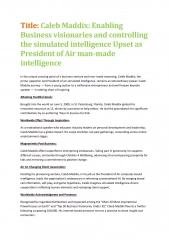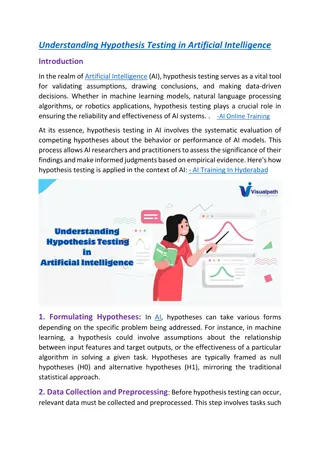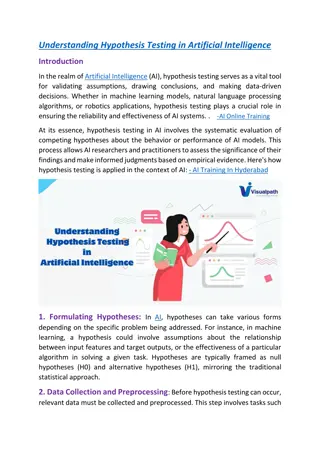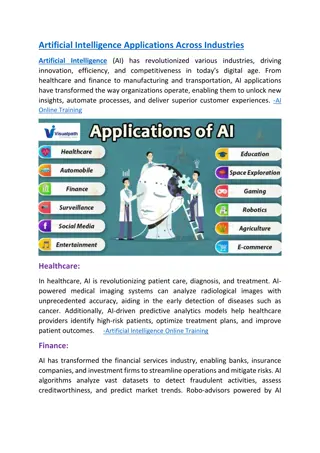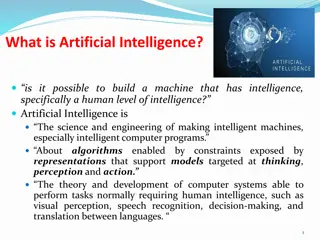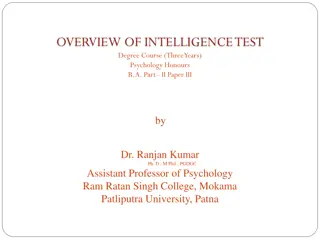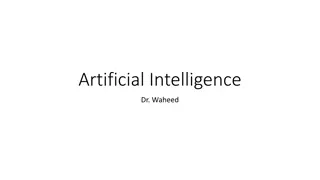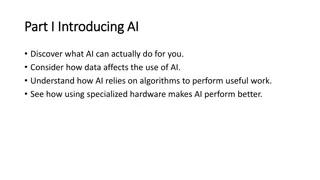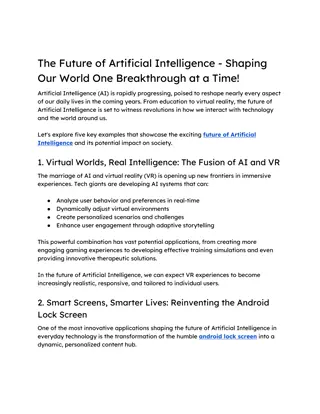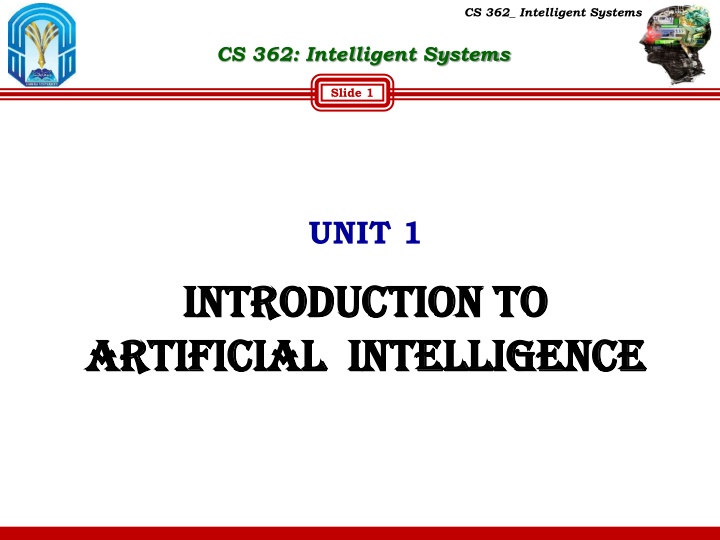
Introduction to Artificial Intelligence in CS 362: Intelligent Systems
This presentation covers the foundational aspects of artificial intelligence in CS 362: Intelligent Systems, with a focus on understanding intelligent systems, course objectives, learning outcomes, and the definition of artificial intelligence. Dr. Abdul Ahad Siddiqi is the instructor for this course, which delves into the role of intelligent systems in contemporary contexts, theoretical and practical concepts, and developing applications utilizing various intelligent system paradigms.
Download Presentation

Please find below an Image/Link to download the presentation.
The content on the website is provided AS IS for your information and personal use only. It may not be sold, licensed, or shared on other websites without obtaining consent from the author. If you encounter any issues during the download, it is possible that the publisher has removed the file from their server.
You are allowed to download the files provided on this website for personal or commercial use, subject to the condition that they are used lawfully. All files are the property of their respective owners.
The content on the website is provided AS IS for your information and personal use only. It may not be sold, licensed, or shared on other websites without obtaining consent from the author.
E N D
Presentation Transcript
CS 362_ Intelligent Systems CS 362: Intelligent Systems Slide 1 UNIT 1 Introduction to Introduction to Artificial Intelligence Artificial Intelligence
CS 362_ Intelligent Systems Instructor's Data Instructor's Data Slide 2 Instructor s name: Dr. Abdul Ahad Siddiqi Course email: ahad66@yahoo.com
CS 362_ Intelligent Systems Text Book Text Book Slide 3 Text Book: Artificial intelligence: structures and strategies for complex problem solving. Author: George F. Luger. Publisher: Pearson Education, Inc
CS 362_ Intelligent Systems Course Assessment Course Assessment Slide 4 ITEM DATE MARK Quizzes Varies 5 Homework Weeks 6 and 13 15 First Exam Week 7 15 Second Exam Week 11 15 Project Week 14 10 Final Exam Set by the college 40 Total 100
CS 362_ Intelligent Systems Course Objectives Course Objectives Slide 5 Develop an appreciation of the role of intelligent systems in the contemporary context. Develop a deep understanding of fundamental theoretical and practical concepts about intelligent systems. Develop several applications employing different intelligent system paradigms
CS 362_ Intelligent Systems Course Learning Outcomes (CLOs) Course Learning Outcomes (CLOs) Slide 6 Recognize ideas and techniques underlying the design of intelligent systems. 1.1 Describe mathematical representations and logic for Solving AI problems. Analyze various search and Knowledge Representation techniques in the design of intelligent systems. Design intelligent systems to solve various AI problems. Appraise team work utilizing effective group techniques to design, implement and demonstrate Intelligent Systems.( mini project). 1.2 2.1 2.2 3.1 Demonstrate intelligent systems using search techniques, Planning and Robotics. 4.1
CS 362_ Intelligent Systems What s Artificial Intelligence (AI) What s Artificial Intelligence (AI) Slide 7 Artificial intelligence (AI) is the branch of computer science concerned with making computers behave like humans (Computers with the ability to mimic or duplicate the functions of the human brain). The term was coined in 1956 by John McCarthy at the Massachusetts Institute of Technology (MIT).
CS 362_ Intelligent Systems The Turing Test The Turing Test Slide 8 Alan Turing in 1950 wrote a paper entitled Computing machinery and intelligence This paper is one of the earliest papers to address the question of machine intelligence specifically in relation to the modern digital computer The Turing test is a test of machine s ability to exhibit an intelligent behaviour. The Turing test (called the imitation game) measures the performance of an intelligent machine against that of a human being. The test places the machine and a human counterpart in rooms apart from a second human being, referred to as the interrogator.
CS 362_ Intelligent Systems The Turing Test (ii) The Turing Test (ii) Slide 9 The interrogator is asked to distinguish the computer from the human being solely on the basis of their answers to questions asked over this device. If the interrogator cannot distinguish the machine from the human, then, Turing argues, the machine may be assumed to be intelligent.
CS 362_ Intelligent Systems Artificial Intelligence Systems Artificial Intelligence Systems Slide 10 Artificial intelligence systems are the people, procedures, hardware, software, data, and knowledge needed to develop computer systems and machines that demonstrate the characteristics of intelligence
CS 362_ Intelligent Systems Artificial Intelligence Behavior Artificial Intelligence Behavior Slide 11 Intelligent behavior: Learn from experience Apply knowledge acquired from experience Handle complex situations Solve problems when important information is missing Determine what is important React quickly and correctly to a new situation Understand visual images Process and manipulate symbols Be creative and imaginative Use heuristics
CS 362_ Intelligent Systems Important Features Important Features of AI of AI Slide 12 The use of computers to do reasoning, pattern recognition, learning, or some other form of inference. A focus on problems that do not respond to algorithmic solutions. This underlies the reliance on heuristic search (as rules for choosing those branches in a state space that are most likely to lead to an acceptable problem solution) as an AI problem-solving technique. A concern with problem-solving using inexact, missing, or poorly defined information and the use of representational formalisms that enable the programmer to compensate for these problems. Reasoning about the significant qualitative features of a situation. An attempt to deal with issues of semantic meaning as well as syntactic form. Answers that are neither exact nor optimal, but are in some sense sufficient . This is a result of the essential reliance on heuristic problem-solving methods in situations where optimal or exact results are either too expensive or not possible. The use of large amounts of domain-specific knowledge in solving problems. This is the basis of expert systems.
CS 362_ Intelligent Systems Techniques used in AI Techniques used in AI Slide 13 Problem Representation (Knowledge Representation): is a science of translating actual knowledge into a format that can be used by the computer Search: a technique to choose the optimal solution from many possible solutions. Automated Reasoning: a process of achieving a specific goal based on the given knowledge. Planning: the ability to decide on a good sequence of actions to achieve our goals.
CS 362_ Intelligent Systems Overview of AI Overview of AI applications applications Slide 14 The two most fundamental concerns of AI researchers are: Knowledge representation: it addresses the problem of capturing in a language (predicate calculus), suitable for computer manipulation Search: is a problem-solving technique that systematically explores a space of problem state (successive and alternative stages in the problem-solving process) for solution space. Like most sciences, AI is decomposed into a number of sub disciplines that, while sharing an essential approach to problem solving, have concerned themselves with different applications.
CS 362_ Intelligent Systems Important Research and Important Research and Application Areas Application Areas of AI of AI Slide 15 Game playing Automated reasoning and theorem proving Expert systems Natural language understanding and semantic modelling Modelling human performance Planning and robotics Languages and environments for AI Machine learning Alternative representations: neural nets and genetic algorithms
Areas of Artificial intelligence Vision systems Learning systems Robotics Expert systems Neural networks Natural language processing
CS 362_ Intelligent Systems (i) (i) Game playing Game playing Slide 18 Game playing involves programming computers to play games such as chess and checkers . Most games are played using a well-defined set of rules: this makes it easy to generate the search space and frees the researcher from many of the ambiguities and complexities inherent in less structured problems. As games are easily played, testing a game-playing program presents no financial or ethical burden.
CS 362_ Intelligent Systems (ii): (ii): Automated reasoning Automated reasoning & theorem & theorem proving proving Slide 19 Automated theorem-proving research was responsible for much of the early work in formalizing search algorithms and developing formal representation languages such as the predicate calculus and the logic programming language Prolog.
CS 362_ Intelligent Systems (iii): (iii): Expert Systems Expert Systems Slide 20 Expert systems involves programming computers to make decisions in real-life situations (for example, some expert systems help doctors diagnose diseases based on symptoms) . Expert systems are constructed by obtaining this knowledge from a domain expert (a person who has deep knowledge (of both facts and rules) and strong practical experience in a particular domain) and coding it into a form that a computer may apply to similar problems. Expert knowledge is a combination of a theoretical understanding of the problem and a collection of heuristic problem-solving rules that experience has shown to be effective in the domain.
CS 362_ Intelligent Systems (iv): (iv): Natural Language Natural Language Understanding Understanding Slide 21 Natural language understanding involves programming computers to understand natural human languages like Arabic. Understanding natural language involves much more than parsing sentences into their individual parts of speech and looking those words up in a dictionary. Real understanding depends on extensive background knowledge about the domain of discourse and the idioms used in that domain as well as an ability to apply general contextual knowledge to resolve the omissions and ambiguities that are a normal part of human speech.
CS 362_ Intelligent Systems (v): (v): Modeling Human Modeling Human Performance Performance Slide 22 Many AI programs are engineered to solve some useful problems without regard for their similarities to human mental architecture. In fact, programs that take nonhuman approaches to solving problems (e.g. chess) are often more successful than their human counterparts. Still, the design of systems that explicitly model aspects of human performance is a fertile area of research in both AI and psychology. Human performance modeling, in addition to providing AI with much of its basic methodology, has proved to be a powerful tool for formulating and testing theories of human cognition.
CS 362_ Intelligent Systems (vi): Planning (vi): Planning and Robotics and Robotics Slide 23 Planning is the ability to decide on a good sequence of actions to achieve our goals. Research in planning began as an effort to design robots that could perform their tasks with some degree of flexibility and responsiveness to the outside world. Briefly, planning assumes a robot that is capable of performing certain atomic actions. It attempts to find a sequence of those actions that will accomplish some higher-level task, such as moving across an obstacle-filled room. Planning is a difficult problem for a number of reasons, not the least of which is the size of the space of possible sequences of moves. Even an extremely simple robot is capable of generating a vast number of potential move sequences.
CS 362_ Intelligent Systems (vii): Languages (vii): Languages and Environments of and Environments of AI AI Slide 24 Some of the most important by-products of artificial intelligence research have been advances in programming languages and software development environments. Programming techniques such as object-oriented programming. environments include knowledge-structuring High-level languages, such as Lisp and Prolog, help manage program size and complexity. Trace packages allow a programmer to reconstruct the execution of a complex algorithm and make it possible to unravel the complexities of heuristic search. Without such tools and techniques, it is doubtful that many significant AI systems could have been built.
CS 362_ Intelligent Systems (viii): (viii): Machine Machine Learning Learning Slide 25 Learning is one of the most important components of intelligent behavior. An expert system may perform extensive and costly computations to solve a problem. However, unlike a human being, if it is given the same or a similar problem a second time, it usually does not remember the solution. It performs the same sequence of computations again.
CS 362_ Intelligent Systems (ix): (ix): Neural Nets and Genetic Algorithms Neural Nets and Genetic Algorithms Slide 26 Computer system that can act like or simulate the functioning of the human brain Most of the techniques in AI (and in this course) use knowledge and search algorithms to implement intelligence. An alternative approach seeks to build intelligent programs using models that parallel the structure of neurons in the human brain or the evolving patterns found in genetic algorithms and artificial life.
CS 362_ Intelligent Systems Major Branches of AI Major Branches of AI Slide 27 A system that approximates the way a human sees, hears, and feels objects Vision system: Captures, stores, and manipulates visual images and pictures Robotics: Mechanical and computer devices that perform tedious tasks with high precision Expert system: Stores knowledge and makes inferences Learning system: Computer changes how it functions or reacts to situations based on feedback Natural language processing: Computers understand and react to statements and commands made in a natural languages, such as English Neural network: Computer system that can act like or simulate the functioning of the human brain Perceptive system:
CS 362_ Intelligent Systems Artificial intelligence = Artificial intelligence = Software that acts intelligently Software that acts intelligently Slide 28 AI centers on methods using Booleans, conditionals, and logical reasoning, with numbers used as needed. AI software need not work like people do, but people can provide clues as to methods. For instance, aircraft don't fly by imitating birds. AI means deep (not superficial) understanding of how to do something (e.g. language understanding versus table lookup). Example: Query "picture of west wing of white house" for Google. AI will become increasingly common in the future, as computers do increasingly complex tasks. Many developments in AI have been "exported" to other areas of computer science (e.g. object-oriented programming and data mining). AI programs that are too slow today may get used eventually as computers increase in speed (e.g. speech understanding).
CS 362_ Intelligent Systems What is AI good for? What is AI good for? Slide 29 AI is not precisely defined, but generally it s for: Problems needing "common sense", like recognizing building types in aerial photos Problems requiring many different kinds of knowledge, like automatic translation of English text Problems only a few experts can solve, like treating rare diseases Hard problems without any good known algorithms, like playing chess
CS 362_ Intelligent Systems Some history of Some history of AI AI Slide 30 1950s: The first programs First speculation about AI (Turing test) Dartmouth Conference: organized by John McCarthy and colleagues for starting a new area in studying computation and intelligence. John McCarthy introduced the term artificial intelligence in the conference. Game-playing Heuristic search methods 1960s: Major progress Lisp programming language by McCarthy Development of symbolic reasoning methods using logical constraints The first natural language and vision programs
CS 362_ Intelligent Systems Slide 31 1970s: Many successes Appearance of expert systems Prolog programming language and various other AI software Symbolic learning is popular 1980s: Faddishness Suddenly AI is faddish and gets much media coverage Lots of AI startup companies, most fail Lots of standalone AI applications, lots of expert systems Neural networks become popular
CS 362_ Intelligent Systems Slide 32 1990s: Maturity of AI AI no longer a fad, but used more than ever (e.g. the Web) AI is embedded in larger systems (like on the Web and in simulations) Genetic algorithms and artificial life are popular Statistical language processing is popular, including speech understanding 2000s: AI is back in fashion Data mining is popular Simulations and games using AI are popular
CS 362_ Intelligent Systems Artificial intelligence Artificial intelligence today today Slide 33 Programs that use artificial-intelligence techniques are usually just pieces of a larger system (like Java classes). "Artificial-intelligence techniques" emphasize conditional statements and logical constructs (like "and", "or", and "not"). Artificial-intelligence code often contains many small pieces, to provide flexible reasoning. Journals with current AI trends: IEEE Intelligent Systems and AI Magazine. More technical are IEEE Transactions on Knowledge and Data Engineering and Artificial Intelligence.
CS 362_ Intelligent Systems Options for implementing Options for implementing AI AI Slide 34 Use an AI programming language Use an AI software package Do AI directly in your favorite programming language
CS 362_ Intelligent Systems Options for implementing Options for implementing AI: (i) Use an AI programming language Use an AI programming language AI: (i) Slide 35 Prolog and Lisp are two programming languages; both have standards. Both emphasize programming in small pieces. Both use emphasize linked lists and recursion. Lisp uses functions, Prolog predicate calculus. Prolog has automatic backtracking and flexible variable binding.
CS 362_ Intelligent Systems Options for implementing AI: Options for implementing AI: (ii) Use (ii) Use an AI software package an AI software package Slide 36 Many software packages are available: CLIPS is a popular standalone system JESS is a popular Java package. Packages have better support facilities (e.g. graphics) than languages Languages have standards, shells don't. Packages may be too rigid for your application. Some packages don't support variables (e.g. neural nets).
CS 362_ Intelligent Systems Options for implementing AI: Options for implementing AI: (iii) Do AI directly in your favorite programming language AI directly in your favorite programming language (iii) Do Slide 37 This is the most popular way today. Libraries and predefined classes for AI methods are available. It's more work to do it yourself, but many AI ideas aren't hard to implement. Programming in Weka, Webots, Unity 3D, etc. seem to be popular for simulation and rapid development.
CS 362_ Intelligent Systems Key difficulties in doing AI Key difficulties in doing AI Slide 38 Successes get exported, and people forget the ideas came from AI. Thorough testing is necessary to show an AI system works. Don't trust quick demos. Methods that cannot be tested easily (e.g. genetic algorithms and fuzzy sets) tend to be overvalued because people can t see when they're wrong. Methods that can show obvious errors (e.g. logical inferences) tend to be undervalued.

